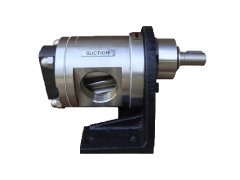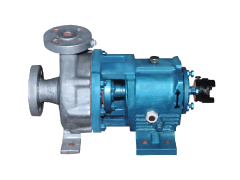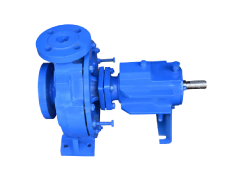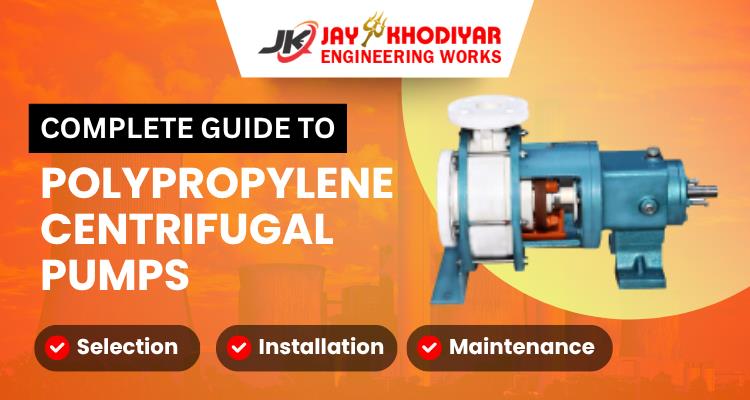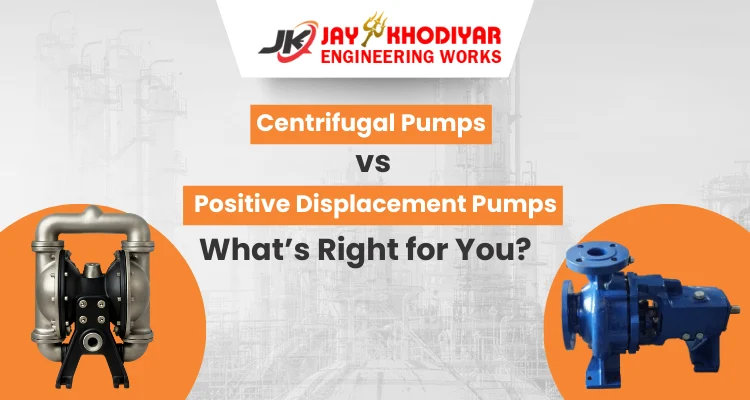
How to Install a Centrifugal Pump: Step-by-Step Guide
May 13, 2025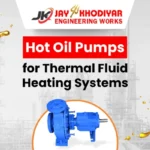
Hot Oil Pumps for Thermal Fluid Heating Systems
June 24, 2025Industrial facilities lose thousands of dollars monthly to pump corrosion. Aggressive chemicals and chlorinated water destroy traditional metal pumps in weeks, forcing costly emergency replacements.
Polypropylene centrifugal pumps offer a better solution. These chemical-resistant pumps deliver 60% lower costs, 70% weight reduction, and 3-5 times longer service life compared to metal alternatives—without sacrificing performance.
Drawing from Jay Khodiyar's 15+ years of manufacturing polypropylene pumps across Gujarat and India, this guide covers everything you need: selection criteria, installation best practices, and maintenance strategies to maximize your pump investment and minimize downtime.
What is a Polypropylene Centrifugal Pump?
A Polypropylene centrifugal pump is a fluid handling device where all wetted parts are made from polypropylene (PP) plastic. Unlike traditional metal pumps, these units resist corrosion from acids, alkalis, and aggressive chemicals.
The pump consists of four main components: a polypropylene impeller that accelerates fluid, a volute casing that converts velocity to pressure, a shaft that transfers motor power, and mechanical seals that prevent leakage.
Chemical process pumps made from polypropylene typically operate as horizontal monoblock units for easy installation and maintenance. Some applications require vertical configurations for space constraints or specific process requirements.
Why Choose Polypropylene Over Other Materials?
- Polypropylene outperforms stainless steel in chemical resistance. While SS316 corrodes in chlorinated water, PP remains unaffected by most acids, bases, and salts used in industry.
- Cost advantages are significant. PP pumps cost 60-70% less than expensive specialty metals like Hastelloy or PVDF. Even compared to stainless steel, initial costs are 30-40% lower.
- Weight reduction simplifies installation. PP pumps weigh 60-70% less than metal equivalents. This reduces foundation costs, simplifies handling, and lowers installation time.
- Maintenance costs drop dramatically.No corrosion means longer service life and fewer replacements. Many companies report 3-5 times longer pump life in chemical service.
Looking for cost-effective chemical pumps? Contact Jay Khodiyar Pumps for expert help!
How Do Centrifugal Pumps Work?
Centrifugal pumps create flow using spinning force. An impeller rotates rapidly inside a casing, throwing liquid outward through centrifugal force.
This spinning action creates three effects:
- Low pressure at the center draws fluid into the pump
- High velocity as liquid moves through impeller channels
- Pressure increases as velocity converts to pressure in the volute
NPSH prevents cavitation damage. Net Positive Suction Head ensures enough pressure exists to prevent vapor bubbles that can destroy impellers. .
What are the Benefits of Polypropylene Centrifugal Pumps?
1. Exceptional Chemical Resistance
PP resists most industrial chemicals. Acids, bases, and organic solvents that destroy metal pumps in weeks have no effect on polypropylene components.
2. Cost-Effective Operation
Lower purchase prices mean faster payback. Reduced maintenance and longer life in corrosive service provide excellent total cost of ownership.
3. Lightweight and Easy Installation
PP pumps require smaller foundations and simpler lifting equipment. Installation time and costs are significantly reduced compared to heavy metal units.
4. Electrical Safety
Electrical non-conductivity provides safety advantages in certain chemical processes. The material won't contribute to galvanic corrosion in mixed-material systems.5. Operating Limitations
Temperature limit: Up to 80-100°C (176-212°F)
Pressure limit: Around 150 PSI for standard units These limits work fine for most chemical processing applications.Which Industries Benefit from Polypropylene Centrifugal Pumps?
1. Chemical Processing and Manufacturing
Acid handling and solvent transfer rely heavily on PP pumps. From sulfuric acid production to pharmaceutical manufacturing, these pumps handle corrosive fluids safely.
2. Water and Wastewater Treatment
Chlorinated water systems benefit from PP's chlorine resistance. Chemical feed systems and brine handling use these pumps extensively.
3. Mining Operations
Acid leaching and tailings processing expose pumps to harsh conditions. PP pumps resist both chemical attack and moderate abrasive wear.
4. Pharmaceutical and Food Processing
FDA-grade polypropylene meets requirements for certain applications. Clean-in-place systems and sanitizer circulation use PP pumps regularly.
5. Textile and Dye Industries
Dye baths and bleaching solutions require chemical-resistant pumps. PP handles both chemical exposure and thermal cycling effectively.
How to Select the Right Polypropylene Centrifugal Pump?
Step 1: Check Chemical Compatibility
Verify your fluid is compatible with PP. While PP resists most chemicals, strong oxidizers and some hydrocarbons can cause problems.
Temperature affects resistance. Higher temperatures reduce PP's chemical resistance and mechanical strength.
Step 2: Calculate Performance Needs
Flow rate: Determine exact requirements plus 10-20% safety margin
Head calculation: Add static lift + friction losses + pressure needs
NPSH requirements: Ensure adequate suction pressure to prevent cavitation
Step 3: Assess Operating Conditions
Solid content matters. Standard pumps handle small amounts of fine solids. High concentrations need special impeller designs.
Pressure and temperature must stay within PP limits. Consider surges and thermal cycling effects.
Step 4: Choose Drive Options
Motor selection depends on power needs and electrical standards. VFDs provide energy savings and process control flexibility.
Need help selecting the perfect PP pump for your application? Get expert consultation
Polypropylene Centrifugal Pump Selection Comparison Table
| Parameter | Standard PP Pump | Reinforced PP Pump | Metal Alternative |
|---|---|---|---|
| Chemical Resistance | Excellent | Excellent | Poor to Good |
| Temperature Limit | 80°C (176°F) | 100°C (212°F) | 200°C+ |
| Pressure Limit | 150 PSI | 200 PSI | 300+ PSI |
| Initial Cost | Low | Medium | High |
| Maintenance Cost | Low | Low | High |
| Weight | Light | Light | Heavy |
| Abrasion Resistance | Fair | Good | Excellent |
What are the Best Installation Practices?
1. Foundation Requirements
- Concrete foundations should be twice the pump weight. Extend 6 inches beyond pump footprint on all sides for stability.
- Level within 0.002 inches per foot to ensure proper shaft alignment. Use precision shims for final adjustments.
- Vibration isolation pads reduce building vibration transmission. Install flexible pipe connections for thermal expansion.
2. Suction Piping Guidelines
- Keep suction lines short and straight. Avoid unnecessary bends that create turbulence and pressure losses.
- Install 5 pipe diameters of straight pipe before pump suction. Use eccentric reducers flat-side-up to prevent air pockets.
- Size foot valves generously to minimize friction losses. Position well below minimum liquid levels.
3. Discharge Piping Setup
- Install gate valves for isolation during maintenance. Add check valves to prevent backflow in multi-pump systems.
- Pressure gauges on both sides help monitor performance. Temperature gauges provide thermal monitoring capabilities.
- Support all piping independently to prevent stress on pump casings. Follow proper piping codes and standards.
How to Operate Polypropylene Centrifugal Pumps?
1. Startup Procedures
- Always prime the pump first. Remove all air from casing and suction lines before starting.
- Check rotation direction before first startup. Wrong rotation reduces performance and can damage components.
- Start with discharge valve partially open to reduce starting torque. Never start against a closed discharge valve.
2. Performance Monitoring
- Monitor vibration levels to detect bearing problems early. Establish baseline readings for comparison.
- Track flow and pressure to verify design performance. Declining numbers indicate wear or system problems.
- Check temperatures regularly on bearings and seals. Hot components indicate lubrication or friction issues.
3. Operational Guidelines
- Avoid low flow operation for extended periods. Install minimum flow recirculation to prevent overheating.
- Never run pumps deadheaded (closed discharge). This causes rapid overheating and damage.
- Rotate standby pumps weekly to keep seals moist and components properly lubricated.
What are Maintenance Practices for Polypropylene Centrifugal Pumps?
1. Daily Inspection Checklist
- Visual inspection catches problems early. Look for leaks, unusual noises, and vibration changes.
- Check mechanical seal leakage. Slight weepage is normal, but steady dripping needs attention.
- Monitor bearing temperatures by touch or infrared. Hot bearings indicate immediate problems.
2. Monthly Maintenance Tasks
- Inspect coupling condition and check alignment. Look for wear, damage, or loosening.
- Lubricate bearings according to manufacturer schedules. Follow specified quantities exactly.
- Clean suction strainers to maintain proper flow. Blocked strainers cause cavitation damage.
3. Annual Overhaul Requirements
- Replace mechanical seals in chemical service annually. Inspect all seal components for wear.
- Adjust impeller clearances to maintain efficiency. Measure and set to manufacturer specifications.
- Replace bearings showing wear signs. Don't wait for complete failure.
Common Problems and Troubleshooting Solutions
1. Cavitation Issues
Symptoms: Noise, vibration, and performance decline
Causes: Insufficient NPSH, air leaks, excessive suction lift
Solutions: Improve suction conditions, reduce piping losses, or install booster pumps
2. Clogging Problems
Prevention: Use proper straining and settling tanks upstream
When blocked: Follow safe shutdown procedures - never clear while running
Long-term: Consider semi-open impellers for better solids handling
3. Chemical Attack Signs
Stress cracking: Fine cracks under mechanical stress points
Swelling: Incompatible chemicals causing dimensional changes
Solutions: Review compatibility charts, consider alternative materials
4. Mechanical Issues
Misalignment: Causes vibration, bearing failure, seal problems
Impeller wear: Reduces efficiency, increases vibration
Foundation problems: Settling causes alignment issues over time
How to Extend Polypropylene Centrifugal Pumps Life and Improve Performance?
1. System Optimization
- Proper piping design reduces energy costs and improves reliability. Size pipes adequately to minimize friction losses.
- Filtration systems remove damaging solids upstream. Balance protection with pressure loss considerations.
- Pressure stabilization reduces surge effects and water hammer damage.
2. Advanced Controls
- Variable frequency drives reduce energy consumption and provide soft starting. Enable precise process control and optimization.
- Automated monitoring detects problems early for predictive maintenance. Install vibration, temperature, and flow sensors.
- Remote monitoring allows expert diagnosis without site visits. Valuable for remote or unmanned installations.
3. Training and Documentation
- Operator training prevents many pump problems. Cover startup procedures, monitoring, and basic troubleshooting.
- Preventive maintenance programs based on operating experience maximize reliability and pump life.
- Detailed record keeping helps identify trends and optimize maintenance schedules.
Conclusion
Polypropylene centrifugal pumps provide an ideal solution for chemical handling applications where corrosion resistance, cost-effectiveness, and reliability are priorities. Their lightweight construction, excellent chemical compatibility, and low maintenance requirements make them the preferred choice for many industrial applications.
Proper selection, installation, and maintenance ensure these pumps deliver years of reliable service. Following the guidelines in this comprehensive guide helps you maximize performance while minimizing total cost of ownership.
Jay Khodiyar Pumps offers a complete range of polypropylene pumps, from standard centrifugal pumps to specialized chemical process pumps and mud pumps. Our experienced team provides technical support for selection, installation, and maintenance to ensure optimal performance in your specific application.
Contact us today for expert assistance in selecting the right polypropylene centrifugal pump that matches your exact chemical processing requirements. With Jay Khodiyar Pumps, you're not just buying a pump – you're investing in a corrosion-resistant solution backed by decades of experience and proven excellence.







